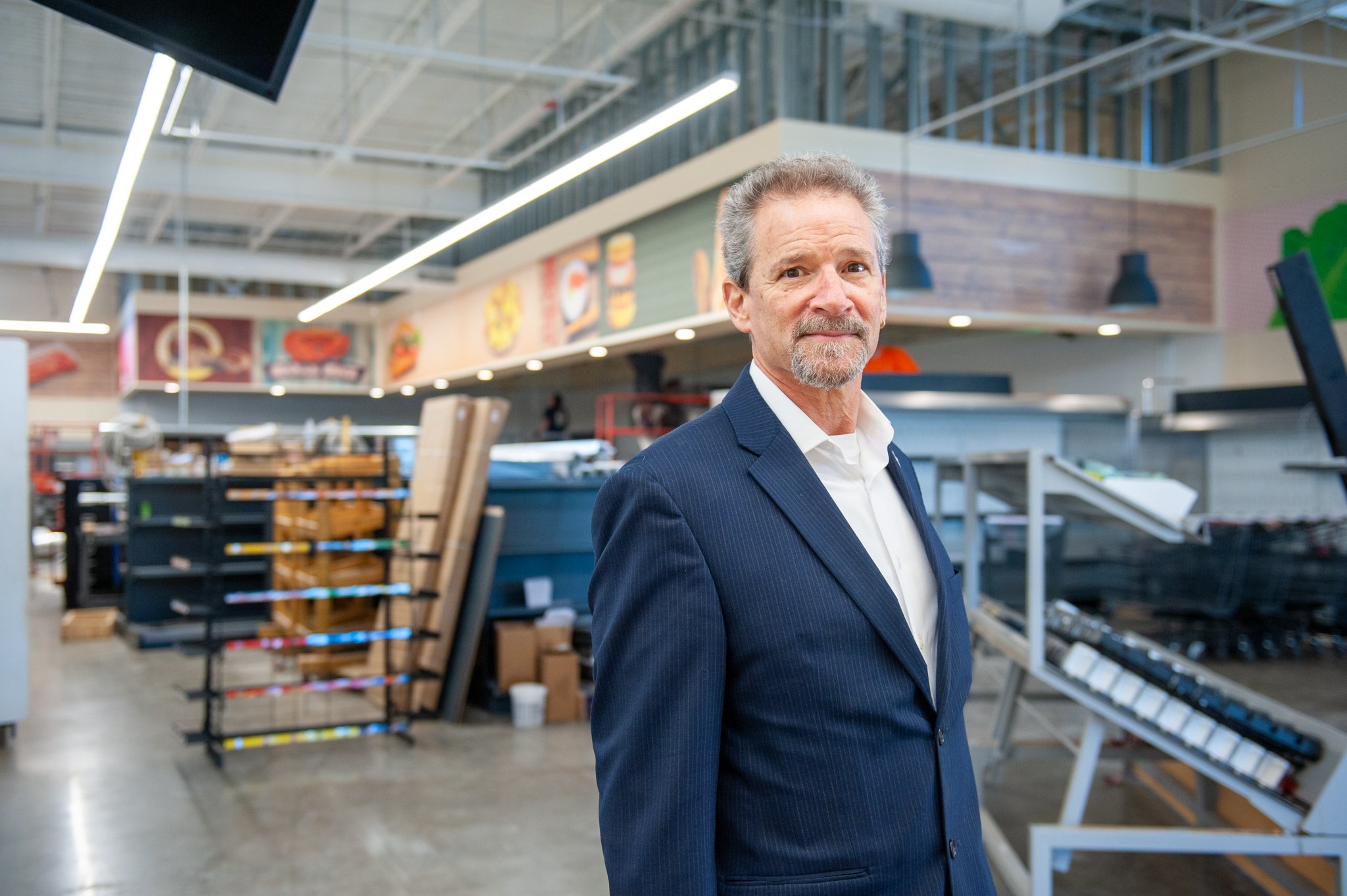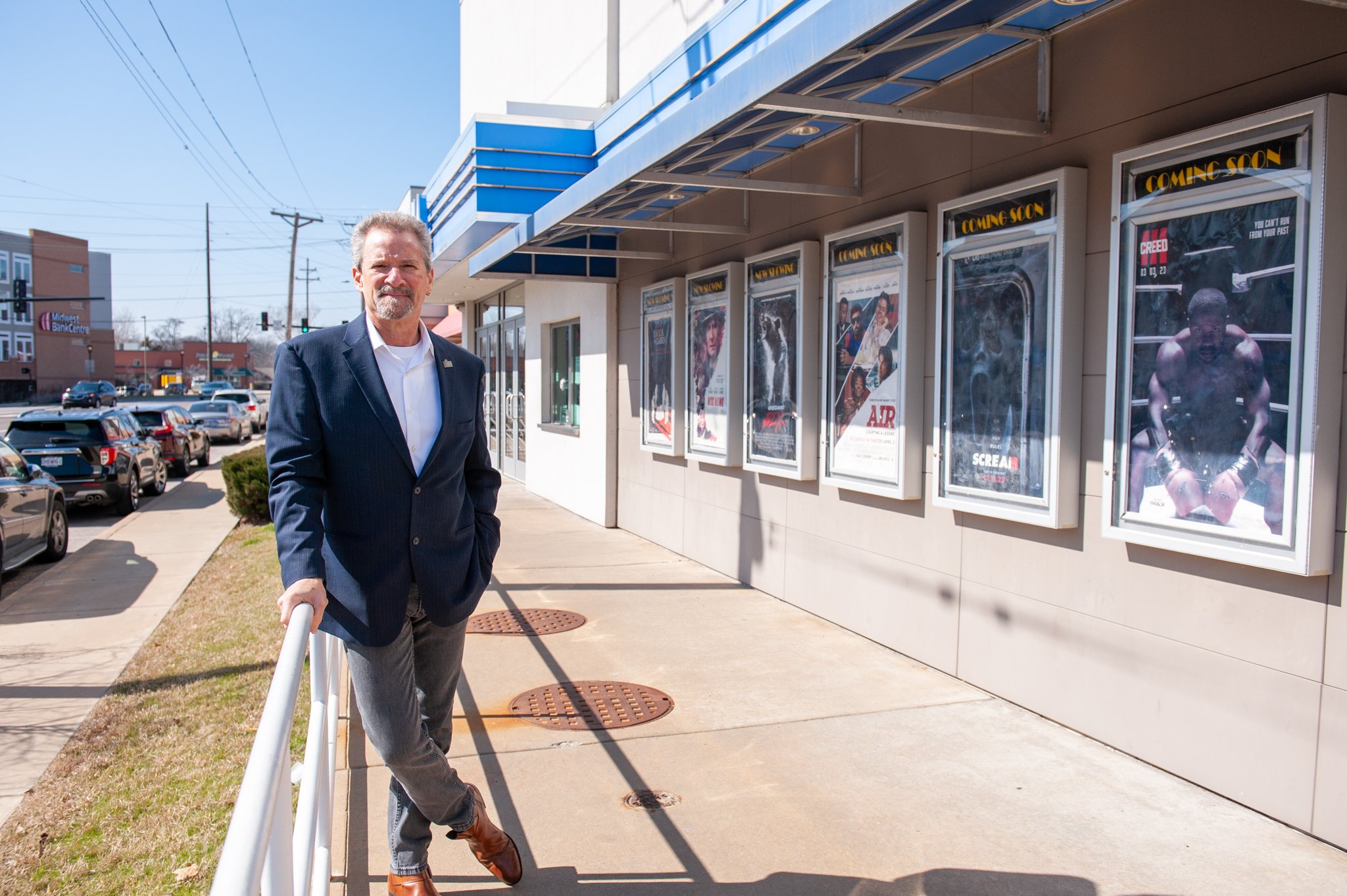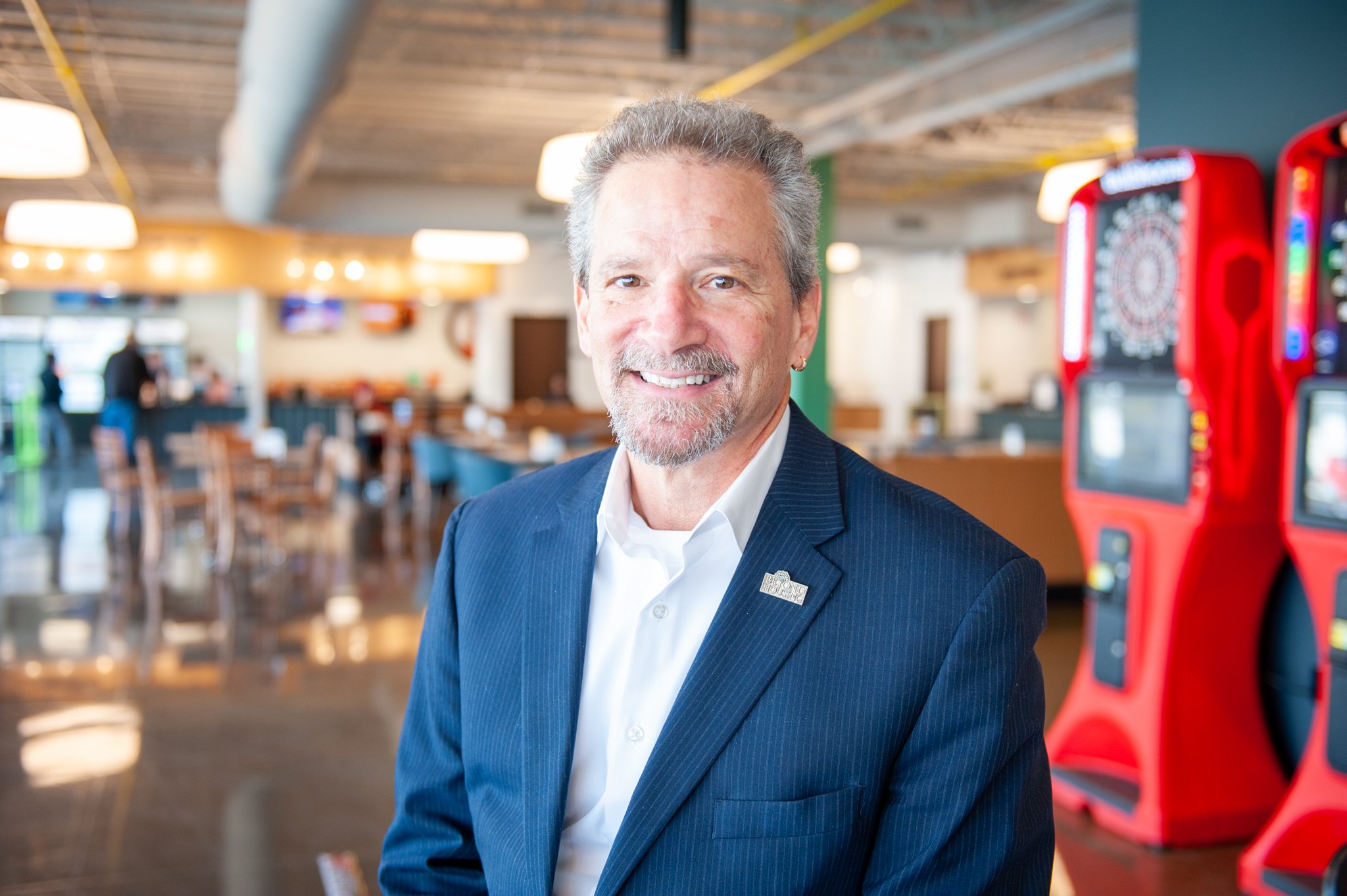Chris Krehmeyer, President/CEO of Beyond Housing, sits down with Humans of St. Louis storyteller Lindy Drew to share the work he and his organization has done in the last thirty years to bring about equitable community change in North St. Louis County. Beyond Housing is a nationally recognized community development organization dedicated to strengthening families and transforming our under-resourced communities to create a stronger, more equitable, and prosperous St. Louis, once and for all.
How can I be at the same job for 30 years? How the hell did that happen? Wasn’t I just 30 years old? We’re sitting at the corner of Page and Ferguson in the City of Pagedale in, what I think, is the heart of the 24:1 Community, which is the boundary of the Normandy Schools Collaborative. One of the biggest memories I have sitting here is with my long time friend and business partner, Mayor Mary Louise Carter, who passed away a few years ago. We’re sitting in Carter Commons, named after her, and I just remember the early days of community work here and how adamant she was that her community was going to get better. She held everyone accountable. “If we’re gonna do it, we’re gonna do it right and do it well.” We started with building some homes around here, but nothing happened and she grew frustrated. She asked if Beyond Housing could come in and build homes and I said, “Sure.”
Since then, we’ve built over 100 homes and rehabbed 200 in the community. We opened up the Pagedale Family Support Center where we do state-licensed after-school programs, summer programs, and a variety of other things. And as we kept asking folks, “What else?” they said, “We haven’t had a grocery store around here since the 1960s. Back then, I knew nothing about economic development other than when someone explained to me what a food desert was, I could tell the area was one. So I told the mayor, ‘We’ll see if we can do that.” She looked at me like I was crazy. But I said, “Why not?” Just the visual change now is stark. I get people saying, “I drove through and was like, what the hell’s going on there?” But if folks don’t come in the dining hall and buy enough of these businesses’ food, they’re not gonna make it. So if you believe in it, come here.”
A lot of times I get asked, “Isn’t this intersection great?” And the short answer is, “Yes.” This intersection is loads better than it used to be. When we started, there was a long-vacant Glaser Drugstore that was falling down and had been closed for decades. Next door was a scary bar. Across the street was Jo-Built Torq Converters. There were two single-family houses and a vacant lot. There was a Chinese restaurant, a banquet hall that had no banquets, a tiny non-denominational church, and a terrible used car place. So we were able to purchase all of it, knock it down, and rebuild this intersection based on what the community said was important to them — a grocery store, housing, access to financial services, a place to sit down to eat, a cinema, and a health clinic. This community gave us direction. We worked hard to figure out how to raise the capital to make it happen. Today we’re moving on with the community to focus on the next intersection and the next and the next.
I know how much work is left to do, so it’s hard for me to celebrate. I tell people that from my office in Pine Lawn, I see people walking to and from Barack Obama Elementary School and they’re my motivation because I know us adults aren’t giving them what they need to live their best lives. We’re still failing them. So I’m unwilling to get off the throttle. With everything we’re doing up here, I’m confident we’re doing the right thing, but it’s not at scale. It’s all nice, but it’s taken me a decade to do this. And we can’t stop here. And it can’t just be us. We had no intention of doing all this ourselves. We just started thinking others would join us. And we need more capital. We’re a wonderfully philanthropic region. I just think the money goes to the wrong places. We need institutions like the Zoo and Forest Park and Washington University. They’re all important things to be a vibrant region, but not to the exclusion of communities and neighborhoods a stone’s throw away. So how do we convince folks to stop sprinkling money around and have the courage to do things differently?
📷| Courtesy of Beyond Housing. Fields Foods ribbon cutting, March 23, 2023.
We’re trying to disprove the belief that things like all these venues can’t work in community. It’s not easy. Look, we got a lot of problems. But by having a grocery store here, nobody’s starving. People have access to good, high-quality food, at a good price. Before, we had a Save A Lot here for 11 years. Fields Foods now opened and it's their seventh store. The way we structured the transaction is that we’re not charging the store any rent. If we did, the math wouldn’t make sense for the owner who’s got to make money. We didn’t ask him or the bank or food shops or any of these businesses to open up here and not make money. We have to disprove the thinking that these businesses can’t work. But what the owner of the grocery store agreed to do is share profits with us. So if they’re profitable, which I’m confident they will be, we’ll share in the financial benefits to that end. We can’t have a West County financial model and assume it’s going to work here. Again, people see movies, people got to eat — so we’re pressing the envelope on what’s possible.
Field Foods in Pagedale almost ready for its grand opening.
I’ve heard this perception that the movies must not be any good because it’s in “this” community. “I’m gonna go to the Esquire or the Galleria.” “Well, have you been to the 24:1 Cinema? Go there. And if we don’t do a good job, call us out. But if you haven’t been, then go.” Look, if we don’t — in this region and in broader society — invest in people and places that have been left behind, we’re all going to continue to struggle whether it’s in St. Louis or elsewhere. With systemic racism and the negative impacts it’s had and the other reasons places have been left behind, there’s this deterioration, abandonment, decay, and all this negativity that continues with that downward spiral. So we need to recognize everything is interrelated and interconnected and we need to intentionally try to turn that around. If all we did as an organization was spruce up this intersection here, it’d be good, but it’s not sufficient enough to turn this place around. That’s why we’re building and rehabbing and have community health workers and staff embedded in schools. Working in the jobs space and on community infrastructure with city leaders, if we don’t do all of that and see how issues and opportunities for growth all tied together, we’re going to continue to fail. Like we have been. In all my work over the decades, there’s nothing we can point to that says there is a community-level change of significance. We’ve spent an untold amount of money on poverty alleviation and where are we at? The answer is we’re not much better than we were 30 or 40 years ago.
What did you think you’d grow up to be when you were younger?
I wanted to play the saxophone like John Coltrane, but I had no musical talent. Then I wanted to play center field for the Mets or the Cardinals. My folks are from St. Louis, but my dad was in the service, so we moved a lot when I was young. We lived in Germany and in New Jersey and came back here when I was in fourth grade. But I didn’t know what I was gonna do after college. Students ask me now, ‘What was your career trajectory?’ and it was to get a job to pay rent. I had no grandiose plan of what to do. I got a degree from Washington University, but what was I gonna do with it? My dad’s an engineer, not by education but by work. My older brother was an engineer by education and now by work. And that gene just flew right past me. My job was to hold the other end of stuff and get my dad a beer.
So when I was in school thinking about what I was gonna do, I took a bunch of classes. Business was kind of boring. I wasn’t dedicated enough for law. Well, I stumbled into an urban studies class because it started late morning, early afternoon. It sounded like I could get a good grade in that. Then when I started the class, I thought, ‘This is kind of cool.’ I worked five years to pay for school in addition to the sizeable loans I had to take out. And when I got my degree and all my debt out of school, I couldn’t find a job. My dad was like, “Told ya so.”
I did internships at the City of Webster Groves and the City of University City and landed a job at the Housing Authority of St. Louis County in 1986 where I made $16,800 starting. I was like, “Cool. I can pay rent.” The first three years I worked in the Section 8 department and every day I saw about 10 families, typically single moms, looking for a place to live. So I’d take their check stubs and birth certificates, put them in our system, give them a list of everyone who accepted Section 8, and say, “Good luck.” And every day I’d hear their stories.
For folks who fly through this intersection or have never been here, what are the changes that were made that affect the everyday person who uses it?
The visual changes are the big dramatic pieces. You’d roll through here and probably wouldn’t remember much. It was pretty nondescript: abandoned, vacant, underutilized. Nothing would stand out because there wasn’t a lot going on here. Once we started knocking stuff down and seeing new things coming out of the ground, things changed. For example, we made the grocery store building all brick instead of out of fake siding to make a statement. The community needed to know they get to have the good-looking stuff. All the buildings are fronted to the street intentionally. We didn’t want parking lots in front, so it was all about what is here. I’m not a big fan of one-story strip malls. The world has enough of that. So, again, it was a sense of a look and feel. We planted trees and flowers, we narrowed the roads, and there’s green space next door to the Carter Commons to do pop-up events. People want to have fun stuff in their community because they deserve to have gathering spaces and pride in where they call home. The community said there was no place to have entertainment, so we did an analysis of if the community sees movies. And, sure they do, but they didn’t have anywhere nearby to go.
So the grocery store model was, we’ll build the store and someone else can operate it. Well, we can build a building. But we called all the movie theater operators in St. Louis and nobody wanted to run the cinema. They asked where it was gonna be, we gave them the address, and they said, ‘Good luck.’ So we’ve been operating it for about eight years. Tickets are $6.50-$9.50 — the most affordable prices in town. The first show was a James Bond film. The level of excitement for the movie theater was greater than the grocery store. And this is also a doctor desert, so we brought health care here. We brought sit-down restaurants and a community kitchen. And we didn’t want to have a lot of social services here. This was meant to be retail to build a vibrant community at a major intersection.
I walk around these buildings all the time and talk to my employees: “How are you doing? How’s work? How’s the family?” Be present and make sure people know you care about them. You know, I’ll pick up trash around the buildings and people say, “Who’s the guy in the suit? What’s up with that dude?” The whole idea of trust-building is never-ending. I never once want people to think, “They can do whatever they want now because they’re Beyond Housing.” No, there are still expectations this community has for how we interact with them and how we do our work. We are imperfect. We’ve made mistakes along the way. I’ve apologized a number of times in public because we didn’t do things the right way. So my hope is when it is time to leave the organization, I’m leaving it in great hands. And I’m gonna walk away and not look back, because the new leader needs to do their own thing and doesn’t need me anywhere near here.
When you meet someone new, how do you explain St. Louis?
There’s the generic, “it’s a small town that occasionally feels like a big city.” Many years ago, a mentor of mine said, “We’re good at polite mediocrity.” Because we don’t want to offend anyone related to tackling the hard stuff and we’re willing to keep kicking the can down the road. So, until we have the regional courage to think about what our problems are and how we are going to solve them in a different way, we’re gonna continue to fade relative to everyone’s perception of St. Louis. Folks are doing things, and it’s not enough. It’s not amplified, nor is it coordinated. We need regional leadership to compel change to happen in a different way than what we’re doing today. And don’t get me wrong, there are a lot of great things happening. And we need to keep doing those things and more if we want to create a stronger St. Louis for everyone.
I get weary of the same old tired conversations about crime and public education and, and, and… In Pagedale, there are indicators of progress. The average sales price of homes per square foot has gone up 338% and, in that same window, crime has gone down 42%. Great trend lines, but not good enough. There’s always more to do. I am hopeful. We’ve been working on it all these years. It’s just about telling a different story. When I talk about the work, I don’t talk about the 24:1 footprint, because that makes it feel small. ‘Where is that? Why would I care about that?’ So I talk about the St. Louis region. Even though some think it’s just a St. Louis City problem. No, it’s a regional problem. And we think we have a model that with enough investment can be replicated. There’s nothing we’re doing here that can’t be used all across the region or even the country. It’s the same methodology — strengthening individuals and families, transforming the physical environment, and creating change at the systems level. And, do all these things in relationship with the community with their voice driving our actions. And I promise, there’s going to be some combination of education, jobs, housing, economic development, and health. Do the work. Get it done. And try to make a difference.
— Chris Krehmeyer, President/CEO of Beyond Housing

















